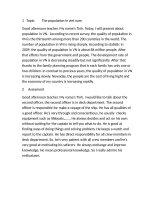Futher evidence on the herd behaviour in the stock market in viet nam
Bạn đang xem bản rút gọn của tài liệu. Xem và tải ngay bản đầy đủ của tài liệu tại đây (936.36 KB, 30 trang )
Further evidence on the herd behavior in Vietnam stock market
Xuan Vinh Vo
School of Banking, University of Economics, Ho Chi Minh City
59C Nguyen Dinh Chieu Street, District 3, Ho Chi Minh City, Vietnam
and
CFVG Ho Chi Minh City, Vietnam,
91 Ba Thang Hai Street, District 10, Ho Chi Minh City, Vietnam.
Email address:
Dang Bao Anh Phan
Faculty of Tax and Customs, University of Finance and Marketing, Ho Chi Minh City,
Vietnam,
2/4 Tran Xuan Soan Street, District 7, Ho Chi Minh City, Vietnam.
Email address:
Abstract
This paper examines the presence of herd behavior in Vietnam stock market using a sample of
299 companies listed on the Ho Chi Minh City Stock Exchange covering the time period 20052015. The study employs the herding measures proposed by Christie and Huang (1995) and
Chang, Cheng and Khorona (2000). We provide a comprehensive analysis using daily, weekly
and monthly frequency. The results indicate the evidence of herding over the whole period
studied. Moreover, the results are robust when we split the data into three sub-periods
including pre-crisis, during crisis and post-crisis. Asymmetric effect is also evidenced under
various market conditions and trading volume.
Keywords: asymmetry, herd behavior, trading volume, Vietnam stock market.
JEL: G02, G10, G12, G15
1
Electronic copy available at: />
Further evidence on the herd behavior in Vietnam stock market
1. Introduction
Herding is defined as a convergence of behavior which means investors follow the action of
others from security to security and from market to market (Choi & Skiba 2015). The
importance of examining the existence of herding arises from its impact on stock market in
particular and on financial system in general. As investors make investment based on collective
decision, the stock prices are driven away from their underlying fundamentals. The divergence
between stock prices and their intrinsic values can result in opportunity to reap profit from
arbitrage. If herd behavior lasts longer and the stock prices fail to adjust towards their
fundamental values, it may lead to the great instability and inefficiency, even the collapse of
financial system.
This paper sheds further light on the presence of herd behavior and the impact of global
financial crisis on this phenomenon in Vietnam stock market. We also examine its asymmetric
effect in terms of different market conditions, various extreme market movements and trading
volume. The data sample includes daily, weekly and monthly closing prices of 299 firms listed
on the Ho Chi Minh Stock Exchange covering the period from 2005 to 2015. We employ the
commonly applied cross-sectional standard deviation (CSSD) method proposed by Christie &
Huang (1995) and cross-sectional absolute deviation (CSAD) method developed by Chang et
al. (2000) to investigate herding in this study.
Our paper is motivated by a number of reasons. The first motivation arises from the
inconclusive conclusion in existing literature about herding in emerging market in general and
limited study regarding this topic in Vietnam stock market in particular. Therefore, further
2
Electronic copy available at: />
investigation is needed to provide a better understanding of the complete picture of herd
behavior in stock markets.
The second motivation is stem from the context of an emerging market. There is a huge amount
of work focusing on the presence of herd behavior in advanced countries. However, herding
tends to be more pronounced in emerging markets where information asymmetry is stronger.
Moreover, stock markets of some emerging countries are gradually developed and make a
contribution to the global financial markets. The increasing importance of emerging markets is
one of the motivations for further investigation about herd behavior in this context.
The third motivation is from the characteristics of Vietnam stock market. For more than
decades from its establishment, Vietnam stock market has undergone a lot of ups and downs
but information transparency has always been an issue. A series of violation in information
disclosure, illegal transactions, and price manipulation along with the shortage of legislation
framework, management of government and operation of auditing enterprise result in the lack
of transparency in this equity market. Bikhchandani et al. (1992) claim that non-transparency
is one of the key reasons leading to herding. Moreover, Vietnam stock market recently has
gained more attention from foreign investors (Vo 2015). With those features of Vietnam stock
market, it is important and interesting to investigate the existence and prevalence of herd
behavior in this emerging equity market
A growing amount of literature has attempted to investigate the presence of herding using
indirect measures by comparing return dispersion of individual stocks to market returns.
Recently, Vo & Phan (2016) examine the presence of herd behavior in Vietnam stock market
utilizing quantile regression analysis. The authors employ model outlined by Chang et al.
3
(2000) with daily data set. The findings indicate that herd behavior is evident in case of market
stress and no evidence is found in the higher quantile of return dispersion distribution.
Moreover, the asymmetric effect of herding exists in Vietnam equity market with the
prevalence of this phenomenon in down market than in up market.
In Vietnam context, this paper extends Vo & Phan (2016) by investigating the presence of
herding and its asymmetry in different market conditions in Vietnam stock market. We employ
cross-sectional standard deviation (CSSD) method proposed by Christie & Huang (1995)
together with CSAD method to achieve main objectives. However, this paper differs Vo &
Phan (2016) in a number of perspectives. Firstly, we examine the asymmetric effect of herding
during extremely upward and downward market movements. Previous research on the topic in
the context of Vietnam stock market is limited so our research extension helps to provide a
better understanding regarding herding in different extreme market conditions. Secondly, we
examine the presence of this phenomenon during global financial crisis as a separate period to
clarify its nature. Global financial crisis is considered a phase of high uncertainty which is more
likely to have significant impact on the existence of herd behavior. However, there is
conflicting evidence of herding in this time period in Vietnam equity market; even there is not
a clear division among stages of before, during and after crisis. Therefore, global financial
crisis period in 2008 is detected separately to investigate its impact on herding.
This paper makes several contributions to the current literature. Firstly, to the best of our
knowledge, we are among the first to provide the evidence of this phenomenon in Vietnam
using daily, weekly and monthly data set ranging from 2005 to 2015 to investigate both middleterm and long-term perspective. Most of previous studies focus on analyzing herd behavior in
short-term based on daily observations. Secondly, we associate level of herd behavior with
4
trading volume in order to find out the relationship between return dispersion and market
consensus when the market is in high and low volume states. This investigation has not been
done before for Vietnam stock market.
The remainder of the paper is structured as follows. Section 2 presents a review of literature.
Section 3 describes data and research methodology. Section 4 reports the empirical results and
section 5 concludes the paper.
2. Literature Review
There is a huge volume of recent work in finance literature attempting to investigate herd
behavior. Theoretically, many studies focus on concepts and classifications of herding
(Bikhchandani & Sharma 2001; Spyrou 2013). Other papers analyze what drives herding and
its impact on financial system. Some argue that this phenomenon drives the prices further from
the fundamental values and causes destabilization (Bikhchandani & Sharma 2001; Hsieh 2013;
Scharfstein & Stein 1990; Spyrou 2013). Others argue that herding actually makes the market
more efficient because prices are adjusted faster to new information (Hirshleifer et al. 1994;
Hirshleifer & Teoh 2003).
On the empirical side, many previous papers examine the presence of herding from
international perspectives. Particularly, a number of studies investigate this phenomenon in a
multi-market setting (Blasco & Ferreruela 2008; Borensztein & Gelos 2003; Chang et al. 2000;
Chiang & Zheng 2010; Choi & Skiba 2015; Hwang & Salmon 2001). Chang et al. (2000)
extend an influential analysis by Christie & Huang (1995) by employing market index returns
of different countries to explore herding propensities. This study reports no evidence of herding
in the US and most other developed countries but strong evidence in two Asian emerging
5
markets (ie. South Korea and Taiwan). Similarly to Chang et al. (2000)’s results, Hwang &
Salmon (2001) investigate the presence of herding in the US, the UK and South Korea and
suggest that herd behavior tends to be stronger in emerging markets than in advanced markets.
In contrast, Chiang & Zheng (2010) find evidence of this phenomenon in some developed stock
markets when employing market index data to compute herding propensities in countryspecific level. Blasco & Ferreruela (2008) investigate herding in seven countries using crosssectional standard deviation (CSSD) measure. The authors find evidence of herd behavior in
only Spain among the sample countries. Borensztein & Gelos (2003) study herding in mutual
funds of 400 emerging markets and show significant evidence in different market conditions
from tranquil to crisis periods. Recently, Choi & Skiba (2015) use a set of quarterly institutional
holdings data of “target countries” including 41 countries in the sample and document the
existence of wide-spread herding propensities.
On the other hand, a huge volume of previous works focus on examining the existence of
herding in a single stock market setting. Table 1 shows some of empirical evidence on herding
in this perspective. The results are different from countries to countries. In general, herding is
not only observed in the advanced market but also widely found in Asian and other European
stock markets.
Several papers in financial literature also examine herding in stock markets at the firms’ stock
level (Choi & Skiba 2015). A few studies have also investigated this phenomenon in other
assets. For example, Gleason et al. (2003) extend previous herding studies on common stocks
to examine herding in contracts traded in European futures markets. They employ the CSSD
method by Christie & Huang (1995) to examine the presence of herding in 13 commodities
futures contracts on three European exchanges (FOX, MATIF, and ATA). They conclude that
6
herding is not evident in this future markets. Oehler & Chao (2000) and Galariotis et al. (2015)
focus on bond markets. In particular, Oehler & Chao (2000) find strong evidence of herding in
German bond market using the sample of 57 German mutual funds. However, the authors show
that herding level is weaker in bond market than in stock market. Galariotis et al. (2015) utilize
the commonly applied CSAD method to examine the return clustering in European bond
market. The results report no evidence of investors herding neither before nor after Europe
crisis. Zhou & Anderson (2011) investigate the market-wide herd behavior in the US real estate
market. Using quantile regression analysis, the authors find that investors tend to herd under
turbulent market conditions. In addition, the findings also support the existence of asymmetric
effect which indicates the prevalence of herding in declining market than in rising market.
7
Table 1: A summary of empirical evidence on herding in single market setting
Countries
The US
Author(s)
Lakonishok et al. (1991)
Period
Quarterly data from 1985 to 1989
Model(s)
Main findings
LSV
The study finds no evidence of substantial herding by US
pension fund managers, except in small stocks.
Nofsinger & Sias (1999)
Monthly data from 1977 to 1996
NS
The results report the presence of herding in both US
institutional investors and individual investors. However,
institutional herding impacts prices more than herding by
individual investors.
Wermer (1999)
Quarterly data from 1975 to 1994
LSV
The authors find little herding by mutual funds in the
average stock but much higher levels in trades of small
stocks in the US.
Jiao & Ze (2014)
Quarterly data from 2000 to 2007
LSV
The findings indicate evidence of US mutual fund herding
and the associated price destabilization effects. Moreover,
the results reveal that mutual funds herd into or out of
stocks following the herd of hedge funds, not vice-versa
The UK
Wylie (2005)
Semi-annual data from 1986 to 1993
LSV
Significant amount of fund manager herding is found in the
largest and smallest UK stocks after adjusting for the
positive bias in the LSV herding measure.
Italy
Caparrelli et al. (2010)
Daily data from 1988 to 2011
CH, CCK and Herd behavior is evident during extreme market conditions
HS
in terms of both sustained growth rate and high stock levels
according to CH model.
Greece
Caporale et al. (2008)
Daily, weekly and monthly data from
1998 to 2007
8
CH and CCK
Herding exists in the Athens stock market.
Germany
Walter & Weber (2006)
Data from 1998 to 2002
LSV
The results provide evidence of herding by German mutual
fund managers. Moreover, the authors find that a
significant portion of herding detected in the German
market is associated with spurious herding.
Spain
Gavriilidis et al. (2013)
Quarterly data from 1995 to 2008
Sias model
The results provide evidence that Spanish institutional
industry herds intentionally for most sectors which are
underperformed; thus, generating high volatility and
volume.
Japan
Kim & Nofsinger (2005)
Monthly data from 1975 to 2001
NS
The authors find the presence of herding in Japan with a
large impact on price movements. In addition, the effects
and behavior of institutional herding depend on the
economic condition and the regulatory environment.
Korea
Choe et al. (1999)
Daily data from 1996 to 1997
LSV
Herding is found by foreign investors in Korea before
economic crisis. However, herding falls during the crisis
and no destabilization impacts on Korea stock market over
the entire sample.
Jeon & Moffett (2010)
Monthly data from 1992 to 2003
Sias model
The study finds evidence of strong impact of foreign
investors herding on stock returns. Moreover, the results
also indicate the opposite direction in buying and selling
shares between foreign and domestic investors in the
herding years.
9
China
Tan et al. (2008)
Daily data from 1994 to 2003
CCK
and The results reveal the presence of herding within Chinese
modified CCK
stock market as well as asymmetric effect in terms of stock
returns, trading volume and volatility.
Chiang et al. (2010)
Daily data from 1996 to 2007
CCK
and Herding is found in within both the Shanghai and Shenzhen
modified CCK
A-share markets but no evidence is reported within both Bshares when using OLS method. Moreover, A-share
investors display herding in both up and down market. By
applying Quantile Regression Analysis, the authors find
supporting evidence of herding in both Exchange
conditional on the return dispersion in the lower quantile
region.
Fu & Lin (2010)
Monthly data from 2006 to 2009
CH and CCK
Herding is not found in Chinese stock market but the
asymmetric effect is found with the prevalence of herding
in up market than in down market.
India
Lakshman et al. (2013)
Daily data from 1996 to 2008
HS
The study shows that herding is observed in India stock
market but not very severe.
Vietnam
Vo & Phan (2016)
Daily data from 2005 to 2015
CCK
Herding is reported in Vietnam stock market, particularly
in the median and lower quantile of return dispersion
distribution. The results also reveal that herding is more
pronounced in down market than in up market.
Note: LSV, CH, CCK, HS and NS refers to Lakonishok-Schleifer-Vishny Model; Christie and Huang Model; Chang, Cheng and Khorana Model, Hwang and
Salmon Model and Nofsinger and Sias model.
10
3. Data and methodology
3.1.
Data
We use daily, weekly and monthly frequency in order to provide a more comprehensive
analysis into the herding behavior in Vietnam stock market. Moreover, daily closing prices of
all stocks listed on the Ho Chi Minh Stock Exchange (HSX) are collected in order to investigate
herding in the short run since herd behavior is assumed as a very short-lived phenomenon
(Christie & Huang 1995). However, Christie & Huang (1995) assert that daily data limit the
manifestation of herding during periods of market stress. Weekly and monthly stock prices of
the same companies are also collected in consideration this phenomenon in longer time span.
All daily, weekly and monthly data sets cover the period from 2005 to 2015. The VN-Index
data are collected and used as a proxy for the market returns. Trading volume is also gathered
to attain the objectives in our paper.
The final data set includes 299 firms yielding 2568, 515 and 122 daily, weekly and monthly
observations, respectively. In addition, we divide our sample into three sub-periods covering
pre, during and post global financial crisis. Specifically, the pre-crisis period (April 2005 December 2007) includes 749 daily observations, the number of observations in global
financial meltdown (January 2008 – December 2008) is 246 and the post-crisis period (January
2009 - April 2015) includes 1573 daily observations.
3.2.
Methodology
We employ equation similar to the method proposed by Christie & Huang (1995) to examine
the presence of herding in Vietnam stock market:
𝑅𝐷𝑡 = 𝛼 + 𝛽1 𝐷𝑡𝐿 + 𝛽2 𝐷𝑡𝑈 + 𝜀𝑡 (1)
where
11
𝑅𝐷𝑡 is the return dispersion at time t.
𝐷𝑡𝐿 = 1, if the return on the market for time period t lies in the extreme lower tail of the returns
distribution, and zero otherwise.
𝐷𝑡𝑈 = 1, if the return on the market for time period t lies in the extreme upper tail of the returns
distribution, and zero otherwise.
In order to quantify the return dispersion, Christie & Huang (1995) propose the use of crosssectional standard deviation (CSSD) method, which is defined as:
𝑁
∑ (𝑅𝑖,𝑡 − 𝑅𝑚,𝑡 )
𝐶𝑆𝑆𝐷𝑡 = √ 𝑖=1 (𝑁−1)
2
(2)
where N is the number of firms in the portfolio, 𝑅𝑖,𝑡 is the observed stock return of firm i at
time t and 𝑅𝑚,𝑡 is the market return at time t. If herding exists, return dispersion will be smaller
during period of market stress because investors will make similar decision. Thus, statistically
significantly negative values of 𝛽1 and 𝛽2 in Eq. (1) indicate the presence of herding. Our
study use the 1%, 5% and 10% cut-off points to define the extreme market movements. As
such, an observation of daily, weekly and monthly market return which lies on the first, fifth
and tenth lower or upper percentile of its distribution is considered as an extreme market
movement.
However, there are a number of inherent drawbacks in the estimation method of Christie &
Huang (1995). Firstly, the definition of extreme return is arbitrary. The authors use the value
of 1%, 5% and 10% as the cut-off points to define the extreme market movements. In reality,
the feature of return distribution may change over time and depend on investors’ opinion, even
differ from each of them. Secondly, the model suggested by Christie & Huang (1995)
recognizes herding under the condition of extreme return only. However, herd behavior may
12
be present at the entire return distribution and become more dominant during period of market
stresses (Chiang et al. 2010).
In order to confirm the evidence of herding in Vietnam stock market, we proceed to estimate
the following equation which is proposed by Chang et al. (2000). This model also follows the
approach of Christie & Huang (1995):
2
𝐶𝑆𝐴𝐷𝑡 = 𝛾0 + 𝛾1 |𝑅𝑚,𝑡 | + 𝛾2 𝑅𝑚,𝑡
+ 𝜀𝑡
(3)
where 𝐶𝑆𝐴𝐷𝑡 is a cross – sectional absolute deviation. It is constructed to measure return
dispersions, which is calculated as follows:
𝐶𝑆𝐴𝐷𝑡 =
1
𝑁
∑𝑁
𝑖=1|𝑅𝑖,𝑡 − 𝑅𝑚,𝑡 |
(4)
where 𝑅𝑚,𝑡 is the market return and 𝑅𝑖,𝑡 is the return of stock i at time t. The return of individual
stock at time t is calculated as 𝑅𝑖,𝑡 = 100 𝑥 (ln(𝑃𝑡 ) − ln(𝑃𝑡−1 )), where Pt and Pt-1 is the closing
price at time t and t-1, respectively.
Chang et al. (2000) assert that the relationship between return dispersions and market volatility
is linear under normal conditions according to rational asset pricing model. Therefore, an
increase in the absolute value of the market returns will lead to a rise in the dispersions of
individual investor returns. However, Chang et al. (2000) notice that during periods of
relatively large price movement, if market participants tend to make decisions based on
aggregate market behavior, the linear relationship becomes non-linear increasing or even
decreasing. In order to find out the non-linearity, the quadratic term of market return variable
R2m,t is included in the regression model. Thus, a negative and statistically significant of
coefficient 𝛾2 in equation (3) will indicate the presence of this phenomenon in Vietnam stock
market.
13
It is important to note that the herding coefficient of 𝛾2 in equation (3) does not account for the
asymmetric effect arising from up and down markets. We further examine whether the degree
of herd behavior is asymmetric in rising and falling markets by utilizing the following models:
𝑈𝑃
𝑈𝑃 2
| + 𝛾2𝑈𝑃 (𝑅𝑚,𝑡
𝐶𝑆𝐴𝐷𝑡𝑈𝑃 = 𝛼 + 𝛾1𝑈𝑃 |𝑅𝑚,𝑡
) + 𝜀𝑡 , Rm,t > 0 (5)
𝐷𝑂𝑊𝑁
𝐷𝑂𝑊𝑁 2
| + 𝛾2𝐷𝑂𝑊𝑁 (𝑅𝑚,𝑡
𝐶𝑆𝐴𝐷𝑡𝐷𝑂𝑊𝑁 = 𝛼 + 𝛾1𝐷𝑂𝑊𝑁 |𝑅𝑚,𝑡
) + 𝜀𝑡 , Rm,t < 0 (6)
𝑈𝑃
𝑈𝑃 2
Where 𝑅𝑚,𝑡
is the market return at time t when the market rises, (𝑅𝑚,𝑡
) is the quadratic term
𝑈𝑃
of the previous one, 𝐶𝑆𝐴𝐷𝑡𝑈𝑃 is the CSAD at time t corresponding to 𝑅𝑚,𝑡
. Symbols are
similarly used in case of the declining market. The market is considered to be rising when its
return is greater than zero, otherwise it is regarded as falling.
In addition, herding is assumed to be more likely to pronounced in extremely high or low
market stress due to psychological reasons (Demirer & Kutan 2006). In order to investigate the
potential asymmetric effect during time of extreme market conditions, we employ the following
models:
𝑈𝑃
2
| ∗ 𝐷𝑡𝑈 + 𝛾2𝑈𝑃 𝑅𝑚,𝑡
𝐶𝑆𝐴𝐷𝑡𝑈𝑃 = 𝛼 + 𝛾1𝑈𝑃 |𝑅𝑚,𝑡
𝑈𝑃
∗ 𝐷𝑡𝑈 + 𝜀𝑡 , 𝑅𝑚,𝑡 > 0 (7)
𝐷𝑂𝑊𝑁
2
| ∗ 𝐷𝑡𝐿 + 𝛾2𝐷𝑂𝑊𝑁 𝑅𝑚,𝑡
𝐶𝑆𝐴𝐷𝑡𝐷𝑂𝑊𝑁 = 𝛼 + 𝛾1𝐷𝑂𝑊𝑁 |𝑅𝑚,𝑡
𝐷𝑂𝑊𝑁
∗ 𝐷𝑡𝐿 + 𝜀𝑡 , 𝑅𝑚,𝑡 < 0 (8)
where 𝐷𝑡𝑈 = 1 if the market return on day t lies in the extreme upper tail of the distribution,
otherwise 𝐷𝑡𝑈 = 0, and 𝐷𝑡𝐿 = 1 if the market return on day t lies on the extreme lower tail of the
distribution, otherwise 𝐷𝑡𝐿 = 0. We determine the 1%, 5% and 10% criterion as upper and lower
tails distribution.
A number of previous authors have associated the level of herd behavior with trading volume.
In order to examine the herding during days with high and low trading volume, the empirical
specifications below are used:
14
𝑉−ℎ𝑖𝑔ℎ𝑡
𝐶𝑆𝐴𝐷𝑡
𝑉−ℎ𝑖𝑔ℎ𝑡
= 𝛼 + 𝛾1
𝑉−ℎ𝑖𝑔ℎ𝑡
𝑉−ℎ𝑖𝑔ℎ𝑡 2
|𝑅𝑚,𝑡
| + 𝛾2𝑉−ℎ𝑖𝑔ℎ𝑡 (𝑅𝑚,𝑡
) + 𝜀𝑡 (9)
𝑉−𝑙𝑜𝑤
𝑉−𝑙𝑜𝑤 2
| + 𝛾2𝑉−𝑙𝑜𝑤 (𝑅𝑚,𝑡
𝐶𝑆𝐴𝐷𝑡𝑉−𝑙𝑜𝑤 = 𝛼 + 𝛾1𝑉−𝑙𝑜𝑤 |𝑅𝑚,𝑡
) + 𝜀𝑡 (10)
𝑉−ℎ𝑖𝑔ℎ𝑡
Where 𝑅𝑚,𝑡
𝑉−𝑙𝑜𝑤
, 𝑅𝑚,𝑡
are the market returns at time t when the trading volume is high and
low, respectively. Trading volume is regarded high if on day t it is greater than the previous
30-day moving average. If trading volume is less than the previous 30-day moving average, it
is characterized low.
4. Empirical results
4.1.
Descriptive statistics
Table 2 reports descriptive statistics on daily, weekly and monthly market returns (Rm,t), CSSDt
and CSADt for Vietnam stock market. Daily average return over the entire sample period is
0.03 percentage with the fluctuation ranges from -6.05% to 7.74%, while weekly and monthly
average returns are smaller with the mean values are below 0.01%. The equity market return
in Vietnam stock market exhibits a high magnitude of volatility with a daily standard deviation
of 1.59%. Weekly returns and monthly returns are lower, which are 0.04% and 0.1%,
respectively.
Table 2: Descriptive statistics for daily, weekly and monthly data from 2005 to 2015.
Daily
Weekly
Monthly
CSSD
CSAD
Rm,t
CSSD
CSAD
Rm,t
CSSD
CSAD
Rm,t
Mean
2.40
1.82
0.03
0.06
0.04
0.00
0.12
0.09
0.01
Median
2.48
1.88
0.04
0.06
0.04
0.00
0.11
0.08
0.00
Maximum
15.26
5.99
7.74
0.15
0.12
0.17
0.28
0.23
0.35
Minimum
0.29
0.13
-6.05
0.01
0.01
-0.18
0.02
0.01
-0.30
Std.Deviation
0.78
0.63
1.59
0.02
0.02
0.04
0.04
0.03
0.10
15
Observation
2568
2568
2569
513
513
514
122
122
123
This table also provides a preliminary description of the CSSD and CSAD series. Previous
authors indicate that when all the stock returns cluster around the market returns, return
dispersions measured by CSSD and CSAD are bound to be low to zero (Chang et al. 2000;
Christie & Huang 1995). When individual returns deviate further from the market returns, the
level of both increases. The daily average values of CSSD and CSAD are 2.40% and 1.82%,
respectively, which indicates the high deviation of stock returns from market consensus. The
study also finds that the average CSSD and CSAD based on weekly and monthly data are lower
than the daily one which implies the declining of dispersion over time. In other words,
individual returns have a tendency to move towards the market returns in the long term.
4.2.
Regression results
We begin with the investigation of the existence of herd behavior in Vietnam stock market by
applying dummy variables regression model proposed by Christie & Huang (1995). Table 3
reports the estimated results. The coefficients of dummy variables 𝛽1 and 𝛽2 measure herding
in extremely downward and upward market movement, respectively. As the definition of
extreme market condition is arbitrary, we choose 1%, 5% and 10% criteria to restrict 𝐷𝑡𝐿 and
𝐷𝑡𝑈 to lower and upper tail of market return distribution.
The negative and significant 𝛽1 and 𝛽2 coefficient under 1% criterion indicates the presence of
herding in 1% lower and upper tail of market return distribution. As the market encounters the
extremely large price swings, individual investors have a tendency to cluster around the market
consensus. The positive and insignificant 𝛽1 in most criteria of three intervals report no
evidence in support for herd behavior in lower tail of market distribution. In case of extreme
16
upward market movement, the positive and significant 𝛽2 coefficients based on weekly and
monthly data indicate that stock dispersions tend to increase rather than decrease. The results
17
Table 3: Regression results for the whole sample using CSSD measure.
Variables
Daily
Weekly
Monthly
1%
5%
10%
1%
5%
10%
1%
5%
10%
2.4100***
2.3989***
2.3689***
0.0554***
0.0543***
0.0527***
0.1135***
0.1108***
0.1089***
155.8422
147.2863
137.5783
61.9564
59.3919
55.5841
31.0974
29.6791
27.2669
-0.5989***
-0.0458
0.2078***
0.0039
0.0043
0.0073***
0.0187
0.0153
0.0141
-3.9099
-0.6467
4.0252
0.6369
1.0845
2.5965
0.6611
1.0109
1.2204
-0.8778***
-0.0298
0.0535
0.0454***
0.0283***
0.0245***
0.1052***
0.0669***
0.0479***
-5.7406
0.0708
1.0353
5.5295
7.1487
8.6897
3.7237
4.4194
4.1439
R-squared
0.0183
0.002
0.0064
0.0568
0.0919
0.1329
0.1068
0.1444
0.1295
F-statistics
23.8936
0.2837
8.2758
15.3705
25.7998
39.0786
7.1124
10.0419
8.8534
Probability
0.0000
0.7530
0.0003
0.0000
0.0000
0.0000
0.0012
0.0001
0.0003
𝛂
𝜷𝟏
𝜷𝟐
Note: This table reports the estimation results of the equation 𝑅𝐷𝑡 = 𝛼 + 𝛽1 𝐷𝑡𝐿 + 𝛽2 𝐷𝑡𝑈 + 𝜀𝑡 in which 𝑅𝐷𝑡 is return dispersion measured by cross-sectional
standard deviation (CSSD) method, 𝐷𝑡𝐿 and 𝐷𝑡𝑈 are dummy variables at time t taking on the value unity when the market return at time t lies in the extreme
lower and upper tail of the returns distribution, respectively; and zero otherwise. (***) denotes significance at 1% level.
18
are consistent with prediction of asset pricing model and contradictory with the definition of
herd behavior which requires the decrease in CSSD measure.
We further apply Chang et al. (2000) model to investigate the presence of herding in entire
stock market in order to overcome the drawbacks of CSSD method in choosing criteria as the
definition of extremely large price swings. Table 4 provides the regression results of empirical
specification given by Chang et al. (2000). Equation (3) estimates separately for daily, weekly
and monthly data over the whole period. Significant and positive coefficients of absolute
market returns (𝛾1 ) indicate a linearity between dependent and independent variables which is
consistent with the rational asset pricing model. Our results reveal the quadratic non-linear
relationship between return dispersion and market returns through the negative and significant
coefficients of square market return (𝛾2 ) which show the existence of herding. It is noticed that
herding coefficients are statistically significant and negative with both daily and weekly data
sets. We therefore conclude that herd behavior is found in Vietnam stock market in short and
middle terms and no evidence supports the existence of this phenomenon in the longer term.
This finding is consistent with the notion of Christie & Huang (1995) that herding is a shortlived phenomenon.
Table 4: Regression results for the whole sample using CSAD measure.
Variables
Daily
Weekly
Monthly
Coefficient
t-statistics
Coefficient
t-statistics
Coefficient
t-statistics
𝜸𝒐
1.5641***
69.0021
0.0313***
27.3257
0.0722***
15.2802
𝜸𝟏
0.4509***
14.5440
0.0401***
7.4899
0.1258
1.2399
𝜸𝟐
-0.1045***
-13.8831
-1.1755***
-2.8479
0.3735
0.8750
R-squared
0.0764
0.2482
19
0.2344
0.0756
0.2453
0.2215
F-statistics
106.0543
84.1891
18.2164
Probability
0.0000
0.0000
0.0000
Adjusted
R-squared
2
Note: This table reports the estimation results of the equation 𝐶𝑆𝐴𝐷𝑡 = 𝛾0 + 𝛾1 |𝑅𝑚,𝑡 | + 𝛾2 𝑅𝑚,𝑡
+ 𝜀𝑡 in
which 𝐶𝑆𝐴𝐷𝑡 is the equally-weighted cross-sectional absolute deviation of returns, Rm,t is the market
returns at time t. (***) denotes significance at 1% level.
We then examine whether asymmetric effect in various market condition exists in Vietnam
stock market by using CSAD measure. Table 5 presents the estimation results based on daily,
weekly and monthly data in rising and falling market conditions. Statistically significant (at
1% level) and negative herding coefficients (𝛾2 ) for daily and weekly data in declining market
imply the presence of herd behavior on days when the market is down. Result is similar for
daily data series when examining this phenomenon in rising market. However, there is
distinction between up and down markets for weekly observations. A negative but insignificant
coefficient (𝛾2 ) in rising market implies herding does not exist in this time interval. Positive
coefficients (𝛾2 ) for monthly data sets mean no herding presence reported even in case of up or
down markets. This finding confirms our above conclusion that there is no evidence supporting
the existence of herd behavior based on monthly data. In other words, market participants seem
to make investment decision rationally in the long term.
Table 5: Regression results in different market conditions.
Variables
Daily
Coefficient
t-statistics
Weekly
Coefficient
t-statistics
Monthly
Coefficient
t-statistics
Panel A: Up market
𝜸𝑼𝑷
𝟎
1.6061***
51.2332
0.0313***
17.8882
0.0683***
8.8355
𝜸𝑼𝑷
𝟏
0.3502***
8.3808
0.4315***
5.1249
0.1706
1.1194
20
𝜸𝑼𝑷
𝟐
-0.0773***
-7.6486
-0.6845
-1.0274
0.5241
0.9707
R-squared
0.0506
0.3428
0.3818
Adjusted
0.0491
0.3375
0.3597
F-statistics
35.1960
68.3212
17.2945
Probability
0.0000
0.0000
0.0000
R-squared
Panel B: Down market
𝜸𝑫𝑶𝑾𝑵
𝟎
1.5152***
46.3774
0.0319***
23.1594
0.0740***
14.0802
𝜸𝑫𝑶𝑾𝑵
𝟏
0.5723***
12.4396
0.3256***
5.1693
0.1433
1.1551
𝜸𝑫𝑶𝑾𝑵
𝟐
-0.1369***
-12.2056
-1.4049***
-2.9791
-0.2279
-0.4774
R-squared
0.1123
0.1548
0.0715
Adjusted
0.1108
0.1479
0.0406
F-statistics
78.4149
22.4326
2.3112
Probability
0.0000
0.0000
0.0000
R-squared
𝑈𝑃 |
2
Note: This table reports the estimation results of the equation 𝐶𝑆𝐴𝐷𝑡𝑈𝑃 = 𝛼 + 𝛾1𝑈𝑃 |𝑅𝑚,𝑡
+ 𝛾2𝑈𝑃 𝑅𝑚,𝑡
𝐷𝑂𝑊𝑁 |
2
𝜀𝑡 , 𝑅𝑚,𝑡 > 0 and 𝐶𝑆𝐴𝐷𝑡𝐷𝑂𝑊𝑁 = 𝛼 + 𝛾1𝐷𝑂𝑊𝑁 |𝑅𝑚,𝑡
+ 𝛾2𝐷𝑂𝑊𝑁 𝑅𝑚,𝑡
𝐷𝑂𝑊𝑁
𝑈𝑃
+
+ 𝜀𝑡 , 𝑅𝑚,𝑡 < 0 in which 𝐶𝑆𝐴𝐷𝑡 is
the equally-weighted cross-sectional absolute deviation of returns, Rm,t is the market returns at time t.
(***) denotes significance at 1% level.
In addition, we also compare the herding level on days when the market is up vis-à-vis days
when the market is down. The comparison is conducted based on daily data. The disparity of
herding coefficients under various market conditions indicates herding in downside market is
stronger than that in upside market.
When the market is up, market participants strongly invest but they tend to imitate the action
of others to get secure. This action is partially caused by the limitation in information
transparency in Vietnamese institutional background. In case of declining market, the non21
transparency together with quality of information published by listed companies also contribute
to raising investors’ risk- aversion. In consequences, individual investors have a tendency to
ignore their own possessive information and make decision based on market consensus.
We further employ add dummy variables representing upper and lower tails of market return
distribution to investigate asymmetry under turbulent market movements. Table 6 presents
empirical results for herding presence during various extreme market conditions. Estimations
are run separately for each time interval with 1%, 5% and 10% criteria as extreme market
movement definition. However, monthly regression results for some criteria are not available
due to limitation in data collection. The results indicate that daily data under 5% and 10%
criteria in extremely downside market generate significant and negative herding coefficients.
It implies that return dispersion tends to decrease during market stress which shows the
existence of herd behavior.
In this time interval, unsystematic risk of individual stocks turns into systematic risk of entire
market which make diversification strategy to mitigate risk less effective. Moreover, most of
individual investors in Vietnam are less experienced with the lack of analysis engine and
limited evaluation ability. Investors’ capability and the stronger decrease of market return may
be the main reasons to reduce investors’ confidence and raise risk-averse sentiment; thus,
investors have a tendency to “flight to safety” during bad time periods (Tan et al. 2008).
We further employ Chang et al. (2000) model to investigate the possible asymmetric effects of
herding with respect to trading volume. Table 7 reports the results of the asymmetric volume
herding regressions. The herding coefficients are both negative and significant. The results
indicate that herd behavior exists during high and low trading volume days. The market with
high trading volume is associated with high liquidity and more publicly available information.
As a result, herding is enhanced in liquid markets since investors have more available
22
Table 6: Regression results during extreme market movements.
Variables
Daily
1%
5%
Weekly
10%
1%
5%
Monthly
10%
1%
5%
10%
Panel A: Extremely upside market
𝛄𝐨
1.8289***
1.8439***
1.8309***
0.0429***
0.0414***
0.0406***
-
0.0855***
0.0834***
112.946
109.722
103.8381
37.6616
38.6672
37.4198
-
18.4039
17.9309
-1.4819***
-0.5880***
-0.0277
-0.9810
0.5093**
0.2203*
-
-0.7176
-0.3321
-10.290
-6.6596
-0.4363
-0.6527
2.4995
1.7119
-
-1.5486
-1.1773
0.2605***
0.1131***
-0.0004
7.4950
-1.7109
0.3379
-
3.2221**
2.0676**
9.6859
5.6541
-0.0244
0.7879
-1.1181
0.3195
-
2.1159
2.0389
R-squared
0.0765
0.0451
0.0028
0.0346
0.1843
0.2082
-
0.2332
0.2721
Adjusted R-
0.0741
0.0437
0.0013
0.0273
0.1781
0.2022
-
0.2058
0.2461
F-statistics
53.9498
31.2322
1.8524
4.7002
29.6011
34.4448
-
8.5164
10.4664
Probability
0.0000
0.0000
0.1572
0.0099
0.0000
0.0000
-
0.0006
0.0001
0.0382***
-
-
-
𝛄𝟏
𝛄𝟐
squared
Panel B: Extremely downside market
𝜸𝒐
1.8329***
1.8512***
1.8397***
0.0389***
23
0.0386***
100.6252
100.4654
97.3740
46.1245
45.1406
43.9294
-
-
-
-0.9745**
0.1865
0.4993***
0.8488
0.0711
0.1255
-
-
-
-2.3127
1.0418
5.5152
0.4959
0.5610
0.1340
-
-
-
0.1644*
-0.0719*
-0.14***
-4.5724
0.0248
-0.3061
-
-
-
1.9244
-1.7637
-6.2518
-0.4582
0.0277
-0.4747
-
-
-
R-squared
0.0194
0.0373
0.0409
0.0093
0.0249
0.045
-
-
-
Adjusted R-
0.0178
0.0358
0.0394
0.0012
0.0169
0.037
-
-
-
F-statistics
12.2393
24.0371
26.4709
1.1541
3.1267
5.7771
-
-
-
Probability
0.0000
0.0000
0.0000
0.3171
0.0456
0.0035
-
-
-
𝜸𝟏
𝜸𝟐
squared
Note: This table reports the estimation results of the equation 𝐶𝑆𝐴𝐷𝑡𝑈𝑃 =
2
𝛾2𝐷𝑂𝑊𝑁 𝑅𝑚,𝑡
𝐷𝑂𝑊𝑁
𝑈𝑃 |
2
𝛼 + 𝛾1𝑈𝑃 |𝑅𝑚,𝑡
∗ 𝐷𝑡𝑈 + 𝛾2𝑈𝑃 𝑅𝑚,𝑡
𝑈𝑃
𝑈
∗ 𝐷𝑡 + 𝜀𝑡 , 𝑅𝑚,𝑡 > 0 and
𝐷𝑂𝑊𝑁 |
𝐶𝑆𝐴𝐷𝑡𝐷𝑂𝑊𝑁 = 𝛼 + 𝛾1𝐷𝑂𝑊𝑁 |𝑅𝑚,𝑡
∗ 𝐷𝑡𝐿 +
∗ 𝐷𝑡𝐿 + 𝜀𝑡 , 𝑅𝑚,𝑡 < 0 in which 𝐶𝑆𝐴𝐷𝑡 is the equally-weighted cross-sectional absolute deviation of returns, Rm,t is the market returns at time t.
(***)(**)(*) denote significance at 1%, 5% and 10% level, respectively.
24
information so they can earn return faster (Gregoriou & Ioannidis 2006). In the context of
Vietnam stock market, the difference between estimated coefficients (𝜸𝟐) suggest that herding
in the low volume state is more pronounced than that in the high volume state. Juvaira & Hassan
(2015) argue that trading volume could be low during large price swings. This reflects the fact
in Vietnam as the stock price volatility is very high over the analyzed period. In addition,
Vietnam stock market is characterized by weak form market efficiency, which respond more
slowly to information together with the lack of available information. These are the main
triggers of herding propensity during low trading days. In conclusion, this finding supports the
fact that herding is related to trading volume level in Vietnam stock market.
Table 7: Regression results during high and low trading volume days.
Variables
High trading volume
Low trading volume
Coefficient
t-statistics
Coefficient
t-statistics
𝜸𝒐
1.7683***
49.9290
1.4075***
50.4079
𝜸𝟏
0.2987***
6.7289
0.5768***
13.8629
𝜸𝟐
-0.0639***
-6.0439
-0.1469***
-14.3491
R-squared
0.0361
0.1337
Adjusted R-
0.0345
0.1325
F-statistics
22.8556
103.5965
Probability
0.0000
0.0000
squared
𝑉−ℎ𝑖𝑔ℎ
|∗
Note: This table reports the estimation results of the equation 𝐶𝑆𝐴𝐷𝑡𝑉−ℎ𝑖𝑔ℎ𝑡 = 𝛼 + 𝛾1𝑉−ℎ𝑖𝑔ℎ |𝑅𝑚,𝑡
𝑉−ℎ𝑖𝑔ℎ𝑡
+ 𝛾2
2
𝑅𝑚,𝑡
𝑉−ℎ𝑖𝑔ℎ𝑡
+ 𝜀𝑡 , 𝑅𝑚,𝑡 > 0 and
𝑉−𝑙𝑜𝑤 |
2
𝐶𝑆𝐴𝐷𝑡𝑉−𝑙𝑜𝑤 = 𝛼 + 𝛾1𝑉−𝑙𝑜𝑤 |𝑅𝑚,𝑡
+ 𝛾2𝑉−𝑙𝑜𝑤 𝑅𝑚,𝑡
𝑉−𝑙𝑜𝑤
+
𝜀𝑡 , 𝑅𝑚,𝑡 < 0 in which 𝐶𝑆𝐴𝐷𝑡 is the equally-weighted cross-sectional absolute deviation of returns, Rm,t
is the market returns at time t. (***) denotes significance at 1% level.
25









